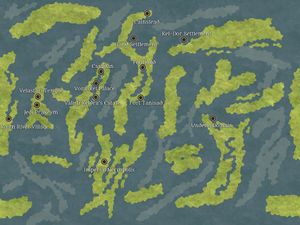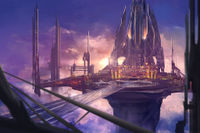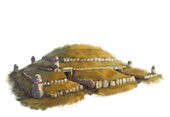Kiast is a terrestrial planet in the Nilgaard sector of the Outer Rim territories inhabited by a subspecies of Sephi, who rule the planet from their highborne skyhooks and floating cities. Its inhospitable surface, and deadly sulfuric atmosphere surrounding it, are contrasted by clear blue skies above the thick cloud cover.
History
Early History - {~2000 BBY}
Recorded history on Kiast began with the settling of the planet, some 2000 years ago by Gand settlers. Finding the planet’s atmosphere more manageable than Type I atmospheres, they settled the toxic surface in an attempt to start several mining colonies. No permanent settlement was ever created, however, the Gand stayed on the surface until this day, ferrying materials and ore from the surface and trading it with the galaxy.
Vatali Colonization - {~900 BBY - 722 BBY}
The Vatali first inhabited the system around 900 BBY, under Lord Ranorm Anasaye. As part of the larger Sephi dominion. Lord Ranorm Anasaye, married to a Sephi princess of royal birth, established a colony on the main planet of Kiast, on one of the larger inhabitable plateaus. During the next several decades, other colonies cropped up on the nearest mountain peaks and plateaus, expanding the domain of the Vatali significantly. By the fifth decade, it had become clear that to expand further and mine the valuable tibanna gas from the planet’s cloud cover, the Vatali would have to construct economical ships and inhabitable skyhooks. Thus the first city was build in the year 927 BBY — the Palace, Voraskel, was constructed.
The next century passed in relative security and peace. New ships were developed, working mostly on gas propelled or repulsor technology, significantly lowering the costs of the starships that were used in mining. New cities and platforms were built, and new gas mining technologies constructed. Each city was a refinery in and of itself, fully self-propelled and self-sustaining. Most of the rest of the platforms were used in intergalactic trade.
Independance - {722 BBY - 537 BBY}
Once Tanisad, Ranorm’s son, took to ruling the Empire, and with his mother’s death, Tanisad began two centuries of distancing from the mother dominion — the Sephi homeworld. Seeing himself as royalty and the true ruler of Kiast, but not lacking the subtlety to understand politics, Tanisad took to controlling the courts to his advantage and slowly turning the nobles against the Sephi domain. It took him nearly two centuries, and he never saw his dream fulfilled as the Sephi maintained a strong loyalty within the navy, something Tanisad could never break.
Meanwhile, the planet developed. Deals were made with the Gand on the surface, and in Tanisad’s reign, settlers were welcome from every corner of the galaxy. They quickly filled the rest of the inhabitable land masses, leaving only few free from colonization. Kyuzo, Melitto and Teedo, as well as Humans and other near-Humans, colonized the world with great speed, and in a mere 200 years outnumbered the Sephi three to one. This called for bylaws to be passed that made all colonists on Kiast subjects of the Vatali king.
It was during King Vatal’s reign that the Vatali intensified their aims to become more independent. Vatal was a fierce king who saw everything through self-interest and ambition, even going so far as creating laws that bound most of the colonist population to his undeniable rule. In effect, he made the colonists his subjects and exploited their labor for the Empire’s gain.
While the Vatali dominion expanded to other worlds in the system, colonizing and exploiting whatever resources were available, the King instigated a coup against his Sephi overlords. The wayward King and his navy, coupled with colonists' ships and soldiers, overtook the loyalist forces. The War for Independence lasted for several long years before coming to an abrupt halt with the capitulation of the Sephi forces and their retreat from the Kiast system. Vatal proclaimed the Vatali Empire, reigning supreme over a whole system of worlds with an iron fist.
Quorahi Wars - {356 BBY - 75 BBY}
Emperor Vatal Anasaye died having fully established a strong dominion over the Kiast system. His reign was the peak in all of the Vatali Empire’s history. No outside force dared to enter his domain without proper respect and gifts and his armada of three hundred ships and airships dominated the whole system. It was truly the golden age of the Vatali Empire.
However, his civil and judiciary rule lacked the same attention to detail and care for his subjects. While he did expand the Empire, his subjects suffered under a dictatorship run by the military. Quorahi were treated as little better than slaves, building massive edifices for their noble overlords. Massive industrial cities were built across the planet, housing millions of people, all working on refineries both on the surface or in the air.
Vatal was succeeded by his daughter, Darsayi — an inexperienced monarch under the sway of the noble houses who looked to their interests above all else — and after many decades of the privileged ruling over the masses, a whisper of rebellion began to emerge. Any that spoke against the Empire and the military were held without trial, and often executed for treason. As the years passed the ember that was the beginning of the rebellion turned into a raging fire.
In 198 BBY the Quorahi turned on their masters, instigating a full-scale rebellion and war against the Vatali Empire. This was the First Quorahi War and it took two years to bring an end to it. The Quorahi were given new laws and special provisions that protected them from the greed of the nobles and the Empress. Decades passed and as generations passed with them, the Empress slowly brought back the old laws in a new and rewritten form. Soon the nobles and royalty began exploiting the Quorahi again.
In 80 BBY, the Empress’ son, Taselm, saw an opportunity to ascend to the throne before all his brothers. He joined forces with a rebellious faction of the Quorahi and gained their loyalty through decisive action and the willingness to cripple the Empire’s efforts. Their cold war against the Vatali lasted for three years before they garnered enough support. In 77 BBY the Second Quorahi War began in earnest as the once-enslaved people turned against their masters again. The rebellion spread across the floating cities and swiftly took control of them within a span of months. The war lasted for two years before the Capital itself was assaulted and Empress Darsayi was executed before the whole Empire.
Taslem took the throne, as an obligation towards the Quorahi and to keep the nobles in check. The Empire survived but with radical changes to how they governed their people. Quorahi were given freedom and became free workers that the Empire employed. All species were accepted as subjects of His Imperial Majesty the Emperor of Kiast, and no person was valued more than the other in the eye of the law. The nobles, however, kept their wealth but lost the power they once held. It was a new dawn for the Vatali Empire.
Age of Reason - {75 BBY - Present}
At the time of his ascension, Emperor Taslem was already an aging Sephi. His rule was benevolent, open and welcoming to the masses. It was a second golden age of development and growth. The military was severely underpowered and maintained a constant vigil rather than a threatening presence. The focus was shifted on scientific research and trade with the outlying systems. The Empire grew and expanded to the farthest reaches of the Kiast system, mining and colonizing many worlds. The tensions between Quorahi and nobility subsided with time and the whole planet seemed to lull into a utopian-like state.
But it was not to last. Emperor Taslem passed away in the 70th year of his reign, leaving the throne empty and three possible successors. The direct lineage belonged to Essadan and Vauzem Anasaye, while the indirect lineage belonged to Taslem’s only surviving sister, the young Kaltani who was only three decades older than her nephews. Essadan was in line for the throne, as a direct successor and the eldest, however, Vauzem had different plans.
During his father’s reign, Vauzem garnered the support of one-third of the noble houses who wanted their power and privilege returned, seeing them as their birthright unlawfully taken. His plan was in motion years before his father ever died and its fruition came in the form of a coup. In one swift strike, the Voraskel Palace was taken and Essadan murdered in cold blood. Vauzem proclaimed himself Emperor of the Vatali domain, rechristening it into the Vauzem Dominion.
His reign was short-lived. The rest of the noble houses, backed by the full might of the Vatali navy and the newly sworn Empress of the Vatali Empire, Kaltani Anasaye, descended upon the Vauzem Dominion. A battle for the Palace broke out as brother fought brother and cousin fought cousin. It was a stalemate until the Quorahi arrived in their industrial cities. Weapons bombarded the Vauzem ships and their floating castle until, at last, they retreated. The day was won and the Empire prevailed, though much of the old Palace was destroyed in the fighting.
Kaltani's reign was blessed with relative peace and surprising stability throughout the first two decades of her rule. Even with the growing turmoil of the galaxy around it, the Empire was able to escape the growing chaos thanks largely to its surrounding nebula and remote location. Yet even as it avoided one war, the government was quickly drawn into another as the members of Clan Odan-Urr sought refuge from the Dark Jedi Brotherhood's onslaught. In 35 ABY, representatives of the Odanites arrived on the world and, after swaying the Empress' opinion in their favour, they were granted worlds to settle on. Areas on the planets of Solyiat, Daleem and the moon of Kaerls were given over to House Hoth, House Satele Shan and the Okami respectively. While the decision proved to be a controversial one among the more hardline nobles, it the Empress nevertheless stood by her decision.
However, over the course of the next two years, the presence of the Jedi and their ongoing war proved to be a major point of content which left the Empress' rule unstable. This was eventually capitalized on by the Vauzem Dominion as they sought to retake the Vatali Empire for themselves and undo the Empress' work. After Beldroth, the ruling Lord of the Dominion, formed an alliance with Ishanta, a rogue Inquisitor nursing a personal grudge against the Lotus Resistance, the Dominion put a plan into action. First poisoning the Empress they then forged a false decree that Alethia Archenksova, Odan-Urr's High Councillor, would serve as Regent in her place. This was then followed by a series of assassination attempts and mass rioting, each attempting to stoke the fires of xenophobia within the Empire and remove support for Archenksova.
A string of unexpected successes by the Odanites rapidly blunted the Dominion's efforts at every turn. Rather than being killed, Kaltani was instead placed into a deep coma by the poison, and several high profile assassination efforts were equally foiled. This removed a possible martyr from their cause. Odan-Urr's ability to both foil assassination attempts and false flag operations then limited the possibility of other uprisings. Although the Dominion would not be driven away as it had been before, the conflict rapidly turned from a swift victory into a bitter stalemate.
When Empress Kaltani awoke from her coma months later, she was able to not only confirm that the decree had been a forgery but quickly countered many of the Dominion's desired reactions. This culminated in the Empress declaring open war upon the Dominion, deeming the group enemies of her Empire. This bold claim readied the Empire for war, but there was little to no immediate shift in the balance of power. With the Dominion's initial strike blunted and their fifth-columnists contained, they lacked the immediate advantage that they had desired for an easy conquest. However, the Vatali were hesitant to directly engage in a costly war which would undoubtedly cause immense collateral damage among their worlds. As such, even as the Dominion attempted to inspire the Quorahi to openly rebel against the ruling nobility and Odan-Urr agents attempted to counteract their efforts, a new plan was enacted. Utilising the Sentinel Network and the Vatali intelligence agencies, the Vatali and Odan-Urr moved to pinpoint the positions and movements of as many key Dominion leaders as possible over the course of the next two years.
The efforts of the Empire finally came to fruition in 37 ABY, as Beldroth Anasaye declared a new Conclave to better cement his power and outline new plans for their next efforts to move against the Vatali Empire. In response, the Empire launched Operation: Vanguard. With so many vital minds behind the Dominion in one place, the SeNet initiated a decapitation strike against the hostile power. With Celevon Edraven Erinos making the opening attack with claimed the life of Beldroth along with several of his bodyguards, Archenkova, Revak Kur and a combined force of Peacekeepers, several Vatali Royal Guardsmen and members of the Knights of Urr stormed the facility where the Conclave was being held. The Dominion leaders who attempted to flee found their routes cut off by Tython Squadron as their aircraft rapidly destroyed air transports while they were refueling.
Simultaneous efforts were repeated across the Kiast system, rapidly ending the Dominion's capacity to coordinate its efforts and maintain any coherent leadership. Within 48 hours of the operation, the Dominion was quickly forced into retreat and its remaining command hierarchy were driven into hiding. The Dominion would remain a threat, but they would ultimately be a spent force unable to counter the Empire as they reeled from this defeat. The goodwill this act garnered allowed for Clan Odan-Urr to be promoted to a noble house within the Empire, and its members were recognised as full citizens with all the rights and duties that entailed. This required a substantial reorganisation of the Clan to fit in with both the Empire's required command structure for a house, and to confront the remaining threat of the Collective.
House Sunrider was given the task of rooting out Collective threats which remained active within the Vatali Empire and spearheading counter-offensives against known enemy strongholds. In this regard it was intended to be a taskforce with the role of safeguarding the Empire through words or, when required, by the sword. Their role was akin to that of the Jedi Order during the reign of the Galactic Republic, and their guardianship was intended to be one more means to help safeguard their adopted home against new threats.
Yet the Collective was not their only pressing enemy. A sudden rise in pirate activity throughout the Empire's north-eastern territories had become a substantial threat to shipping. This would have been a relatively minor problem in of itself, but greater examination quickly unveiled a more pressing problem. A large ship had attempted to enter the Palioxis Cloud and had detonated under repeated collisions. This had created a noted rift in the natural defenses surrounding the system, which had allowed the Vatali Empire to protect itself against far greater powers. In response, the newly formed House Sunrider was established to help defend against enemy incursions from this region. Establishing an XQ1 Platform as both its main headquarters and early warning position close to the rift, its fleet was tasked with patrolling the surrounding area and guarding it against possible threats.
The system was further destabilized as the Quorahi, dismayed at the civil war and frustrated at their apparent lack of power, sought to unify their tribes in an alliance. Foothold, Cainstead, the Gand colonies, and several others, participated in these gatherings over time. Definitive proof of this was only gathered during mid 37 ABY, when a face-to-face gathering between various mayors, leaders, and representatives, took place in Foothold's outlying districts. This meeting was monitored by agents of Odan-Urr, and it confirmed that certain elements were hostile to the Vatali or sought to use the opportunity to settle old scores. The Empress did not react or fully regard this as a threat but allowed for Odan-Urr to respond to the threat as required. The clan was able to quickly both sway Jalan, Foothold's mayor, into switching sides and collapse Cainstead's mines. This both gave them the support of a major figure and denied them a source of economic strength.
Their victories were soon stalled by the unexpected arrival of further support for the Quorahi. Survivors of the Dominion's loss, led by Commodore Arcturus, met in private to support the Quorahi. Offering military aid, training, and the use of a private spy-network, he offered the group a major power boost. Worse still, as proof of their abilities, he alerted the group of Jalan's betrayal and private meetings with the Empress. Emboldened by this support, the remaining tribes announced the founding of the Quorahi Nation. This was soon followed by a major offensive on Fort Tanisad, a vital but weakened military facility. The presence of Jedi on the site thanks to a tour of its defences allowed the base to evacuate and end the lives of traitors within its leadership. Yet, even damaged and scuttled, the Vatali soon took the facility.
The Fort's capture forced the Vatali leadership to finally acknowledge the threat that the Quorahi Nation posed, and that there was a genuine uprising capable of overthrowing them. In an emergency meeting between representatives of their leaders and House Sunrider, the group discussed the potential risks they faced. Realising that Jalan's negotiations had been discovered, the group soon moved onto a war footing. This proved fortuitous, as the Quorahi Nation directly assaulted the Voraskel Palace itself mere days later. Despite their defences, a combination of orbital support and sheer numbers soon began to overwhelm the defenders. Arcturus led a major spearhead, breaching the palace and killing several members of the royal family. He revealed that he was not only a powerful Force user but wielded a lightsaber with expertise while taking Vosen Anasaye hotstage. His goal soon became clear: Argen Anasaye, the Empress' husband, was Force-sensitive and as was their daughter Anaya. Having killed Argen, Arcturus planned to take Anaya hostage and then training her as his apprentice. This threat was only ended when he was slain in a duel with Raziel, and his ship overrun in a boarding action. With their leadership decapitated and major support removed, the Quorahi assault stalled and was then driven back.
In the wake of the uprising's abrupt end, the Empress' had all members of its leadership but Jalan executed. However, recognising the reasons why the Quorahi Nation had seen so much support, the Empress agreed to give the Quorahi greater power and self-governance, albeit with the Vatali retaining judicial oversight of their laws. Along with agreements of disarmament and further outlines of control, the two sides' agreement became the Foothold Concordant.
Geography
 A map displaying all notable locations present across the planet's surface
A map displaying all notable locations present across the planet's surface
Kiast’s geology is rather unique. Due to the binary subdwarf system it formed in, Kiast has developed under high gravitational pressure from its parent stars into a small, but tectonically active planet. Its revolution is an imperfect ellipse, rather than a circle, which creates a very unique effect on the planet surface. Its proximity to the binary star, coupled with its irregular orbital path, has a straining effect on its tectonics as the planet is constantly pulled and pushed against the gravitational forces of the stars.
The surface becomes tense and crumbles as the planet nears the star in its summer months, excreting toxic gasses from multitudes of newly formed geysers. Due to the undersurface activity and the movement of the mantle, Kiast’s core is extremely active and creates a surprisingly strong gravitational field on the surface, holding the heavy gasses close to it.
Over billions of years, the surface has changed many times as tectonic plates — of which Kiast has twenty-seven — shift and create new mountain ranges. Some of these mountain peaks, and indeed large plateaus, penetrate the thick cloud cover and create natural islands of ground and greenery where colonies can be built.
The surface is a vast, alien area for any oxygen-breathing species. It is covered with a mixture of natural forming chlorine, carbon monoxide, sulfur hexafluoride and tibanna gases. The concoction is enough to kill anyone not wearing thick environmental suits on the surface. The pressure at surface level is easily sixty times standard, able to crush any living creature not adequately protected. Most of the surface, however, is covered in sulfuric oceans, formed from sulfuric rain and high pressure. The temperature on the surface is a scorching 200 degrees plus.
Despite its inhospitality, the surface is resource-rich and often exploited through mining in very expensive and very dangerous mining missions. The risks of tectonic activity in summer months often means that workers have to spend winters, when temperatures are low and the surface is increasingly more stable due to the planet’s orbital path.
Landmarks
Voraskel Palace
 Voraskel Palace
Voraskel Palace
The Voraskel Palace, nicknamed the “Steel Star,” is the administrative and economic capital of the Vatali Empire. This magnificent city hovers well above the planet’s noxious cloud layer, kept in the air by massive repulsorlift engines. Many of the system’s commercial institutions base their headquarters here, and it is also the seat of government of the Empire.
The Palace was first built in 927 BBY by King Ranorm, to serve as a tibanna gas refinery and royal residence. Since then, it has remained at the centre of Kiast’s history and politics. In 4 BBY the old Palace was mostly destroyed during a battle, but the Empress has since built an even more majestic complex in its place.
The floating construct is shaped like an irregular spinning top. The topmost structure is the Palace itself, and it rises up from the wide open-topped concourse. The city then narrows again below the concourse and tapers to the bottom levels.
The graceful spires of the Palace house the Imperial family, the Astral Throne, the government ministries, the Vatali Conclave, the High Court chamber, the justice courts and the military command of the Empire. The Palace rises above the concourse, which is the widest level of the city. Here a straight causeway connects the airship docks and landing platforms, goes through the financial district and enters the Palace, to terminate at the gates of the throne room. The concourse also accommodates the luxury apartments of the Sephi nobility, the Flight Academy, the Imperial botanical gardens and a retired museum-airship called the Age of Reason.
Below the rim of the concourse are the huge repulsorlift engines. These incorporate the tibanna refineries, though some of the old Ranorm-era infrastructure has been turned into art galleries. In the downward cone of the city are the dazzling high street and commercial districts, many affluent residential neighbourhoods and, directly below the Palace, the barracks and hangars of the Royal Guard. Descending further, Quorahi neighbourhoods cluster around the indoor Statuary Park. These residents are mainly employed in the service industry that centers around the wealthy Vatali nobility.
Essadan
 Essadan
Essadan
A cluster of cities built near the Voraskel Palace, Essadan lingers above a thin section of the toxins covering Kiast's surface. Oftentimes, this results in the mining operations on the surface being visible through the hazardous gases below the floating cities. Constructed during Vatal's reign, Essadan's cities are contained within dome-like structured fixed atop a stabilizer bearing numerous repulsorlifts.
Over time, it is possible for the cities to drift as the volatile surface below changes. These movements are not noticeable unless observed over long periods of time, but happen as the cities move to where lighter gases are more abundant to aid in lifting the structure. These cities are under the reigning monarch's direct rule, with each of the individual structures being managed under a landlord.
Undelm Domain
 Undelm
Undelm
Mirroring the design and function of Essadan, the Undelm domain is a collection of floating cities within the Vauzem Dominion. Closer to the toxic band than most cities, its cities are designed to shield themselves from toxins that might venture further from the surface as vents containing the gases open on the surface. However, as the Vauzem Domain is noted to be significantly less prosperous than the Vatali Empire, these cities are prone to widespread infections occurring among their residents. Many times, this is a result of their atmospheric shielding failing to prevent harmful toxins from leaking in. Unlike Essadan, the cities of Undelm are individually governed under a Sephi noble belonging to the Vauzem Dominion.
Ever since Kaltani Anasaye rose to power, Undelm's cities have been floating further from the Vatali Empire and across its borders of protection. While this would ordinarily make them prime targets for pirate factions, no documented attacks have been made.
Imperial Necropolis
The Imperial Necropolis is located on the plateau of Mudri in the southern temperate belt of Kiast. It is surrounded on most sides by taller peaks, creating a sheltered basin with a mild climate. The seven burial complexes of the Necropolis are scattered among the foothills of these peaks, while a small settlement occupies the center of the plateau.
The central settlement houses the population of permanent caretakers who look after the buildings and statues, tend the surrounding park and prepare the tombs for visits and ceremonies. The settlement also has landing platforms and facilities for tourists and pilgrims, who are permitted to see all but the sarcophagus chambers of the complexes. Visitors are expected to bring offerings of food, rich textiles or credit chips.
 Tanisad’s burial mound
Tanisad’s burial mound
The first to build at Mudri was King Tanisad. Over the seventh and sixth centuries BBY he constructed his own tomb and that of his father, probably intending to consolidate his legitimacy in the Kiast system in contrast with the faraway Sephi overlords. The model of construction that he established has remained essentially unchanged up to modern times. The burial complex is enclosed by walls, with a grand gate granting entrance. The avenue then leads to a shrine containing an enthroned statue of the deceased monarch, usually larger than life-size. The edifice also contains the historical archives pertinent to their reign. Surrounding the shrine is a statuary garden, with sculptures of warriors and state functionaries. At the far end of the enclosure is the burial mound; this covers a system of chambers containing treasures, murals, personal effects and the sarcophagus itself.
By far the largest complex on the plateau is that of Emperor Vatal, who exploited Quorahi labour to build a monumental shrine and a gigantic statue of himself, as well as a network of underground chambers that spanned many levels below the burial mound. Unfortunately, little remains of the riches that must have been stored in his tomb (and the same is true for those of Ranorm and Tanisad), because of the looting that took place in the First Quorahi War. The effects of the two Quorahi Wars can also be seen in the tomb of Empress Darsayi, which was never properly completed.
 Vatal’s shrine, containing his enthroned statue
Vatal’s shrine, containing his enthroned statue
The tomb enclosure of Emperor Taselm is made remarkable by its unique collection of statues, which for the first time included prominent Quorahi officials, rather than just Sephi. The statues were also rendered in an attitude of festivity, in contrast with the severe military style of previous complexes. Taselm was also the monarch who established the extensive park that surrounds the burial complexes.
The brief reign of Vauzem Anasaye saw the initiation of an ambitious project, as the Emperor set about building a colossal mausoleum on a high peak, overlooking all the other tombs. However, the war of succession of 4 BBY put a stop to that, and all that remains are the foundations and possibly some underground chambers. Nowadays the Necropolis caretakers only enter the site to ensure that visitors do not leave any offerings.
Empress Kaltani, the ruling monarch, has begun the construction of her tomb next to that of Vatal, and where her father’s memorial is one of tremendous might, hers promises to be a pleasing synergy of Sephi and Quorahi competences. The earthquakes of 29 and 30 ABY have delayed the project somewhat, as resources were redirected to the repair of the older tombs.
The liveliest period for the Necropolis is the annual festival of summer’s end, which sees the arrival of large crowds of pilgrims. The festivities culminate with the Imperial visit, when the Empress leads a ceremonial procession to each of the six tombs (excluding the Vauzem mausoleum) and makes offerings on behalf of her subjects. The sovereign will then select a particular tomb and enter the sarcophagus chamber on her own, to make personal propitiations and, it is said, petition the deceased monarch for guidance in the year ahead.
Locus Vera Farm
- Main article: Locus Vera Farm
 Locus Vera plants being harvested.
Locus Vera plants being harvested. The Locus Vera Farm is a massive irrigated plot of land on Kiast's mountainous reaches that grow the plant now called "Locus Vera". At first glance, they appear to be ordinary farms but the very tips of the purified ascendant crystals that embedded themselves into Kiast’s crust can still be seen occasionally poking through.
The purified crystals have interacted with the soil of Kiast to naturally produce the Locus Vera, a legume that produces fruit that heals the body and mind. Green in appearance, the Locus Vera looks like a typical green legume that could easily be mistaken for another plant, save for the distinctive blue fruit that it produces.
Jedi Praxeum
- Main article: Jedi Praxeum
The Jedi Praxeum is a complex of structures harmonized with the landscape, where tall spires and agricultural land cling to the Or’ena Mountains. Once a Sephi military outpost, the Praxeum is now a haven for the Jedi of Odan-Urr. As a Jedi Academy, it sees to the training, education and growth of the Clan’s Novitiate and Journeymen Jedi. From Youngling to Knight, the curriculum maps out a program of study that includes lightsaber combat practice, general studies, survival skills and guidance on the use of the Force. In addition, the academy encourages its students to put what they learn into practice, whether it be in the campus’s obstacle courses, the danger of the campus terrain, or in the wider galaxy.
The Praxeum also places a strong focus on the spiritual growth of the students. Teachers guide their charges through the Jedi Code and how it is understood and practiced by the Jedi of Odan-Urr. Although the Academy provides support in all stages of the students’ education, the young Jedi are also taught to be humble and self-sufficient by participating in the Praxeum’s self-sustaining system of agriculture and textile production.
Atmosphere
Kiast’s atmosphere is unusually thick for a planet of its size, attributed to its high gravity and fast spin. Fully one-third of the atmosphere is covered in a mixture of natural forming chlorine, carbon monoxide, sulfur hexafluoride, and tibanna gases, making everything under that line deadly to oxygen-breathing humanoids.
The second third of the atmosphere is covered in breathable gases, such as oxygen, nitrogen, helium and others. In all respects, it is breathable for all oxygen-breathing humanoids. Life thrives in this area in floating cities and airships that travel the vast expanses between isolated mountain peaks that penetrate the cloud cover.
The final third is the stratosphere and beyond, reaching all the way into space. This area is dominated by skyhooks and orbital space stations and shipyards that usually function as trading hubs for spacers.
Notable Fauna: The Haar Beast
| Haar Beast
|
|
Reptomammal
|
|
Kiast (Planet)
|
|
Unknown
|
|
Est. 5 to 12 metres
|
|
Est. 30 to 80 metres
|
|
Grey
|
- Sensor resistant presence
- Extreme pressure and heat resistance
- "Force wake" effect
|
Due to its hostile nature, what fauna is native to Kaist is limited primarily to the extremely high mountains. These are typically either small creatures which have adapted to the gasses or silicon based creations which favour burrowing beneath the earth, albiet with a few exceptions of oxygen breathers and small colonies of species introduced from offworld.
However, the Haar Beast is both the most infamous and by far the largest local creature known to reside on the world. Although known of for centuries and even warned against by various airship captains, little more than basic estimates and details can be gathered, even by the most advanced equipment. Thought to be up to eighty metres in length going by most accounts, these creatures are reptomammals which "swim" through the thicker atmospheric currents of Kiast through some unknown means. Travelling in small pods of up to twenty by most accounts, they seem resistant to the incredible pressure and heat of the gas layer to the point of outright ignoring its effects. Beyond outlandish accounts of trying to devour airship sailors, most indications suggest they are not carnivorous or at least do not consider humanoids a worthwhile meal.
Most encounters with the creatures stem from near misses with the largest creatures of these pods. Emerging in the paths of airships which stray too close, these beings will ram and even outright destroy vessels they deem a threat to their family group. Most are thought to be the eldest of their kind, bulls too old to effectively mate, and thus play the role of guardian to the wider herd. Although much of this is supposition, it would explain why they put themselves in danger, and guard smaller kin incapable of flying at the same heights.
Yet perhaps the most troubling quality of the Haar Beasts is their simple inability to be effectively tracked and logged. No effective sensor seems capable of pinpointing their locations, from atmospheric detectors to lifesign scanners. Even when a ship is all but directly atop of them, each will simply refuse to accept their presence without even detailing a distortion. Although not unique to some galactic species, the Haar Beasts take such resistant qualities to new heights. Visual captures of them distort in very short spaces of time, corrupting beyond all use through some unknown quality. Even archaic chemical photographic means has proven incapable of capturing anything beyond extremely blurred imagery, lacking any fine details. Quite how the creatures can accomplish this remains unknown, but it has made research efforts all but impossible and reliant heavily upon eye witnesses. Some suspect that there is a passive Force sensitivity natural to their kind. Passengers with a strong link to the Force claim to have felt an "aetheric pressure" or void during close encounters with them, but are otherwise incapable of registering their presence through the Force.
No successful capture of any beast has yet been made, but occasional teeth and skin remnants have been taken from hunting efforts by the Quorahi brave enough to attempt such a venture, and survivors of attacks on transports intruding upon their territory.
Political Landscape
 A'lora Kituri and Turel Sorenn discuss Odan-Urr's involvement in the Vatali Empire
A'lora Kituri and Turel Sorenn discuss Odan-Urr's involvement in the Vatali Empire
The Vatali Empire
- Main article: Vatali Empire
Long before the Jedi of Odan-Urr ever arrived, Kiast has been under the peaceful rule of its current monarch. Refined over centuries, the politics of Kiast have become set into a mixture of subtle intrigue and a pattern of rule that has not been broken in three millennia. The Vor floats above the unforgiving landscape, being the seat of most of the world’s politics.
The current monarch, Empress Kaltani Anasaye, has created a united Empire from several of the most prominent and largest surface cities on Kiast, solidifying her rule as the most advanced faction with ready access to mining, water and other necessities. Under peaceful rule, her advisors from the regions offer their thoughts in the Palace’s throne room. For matters that rise above trivial pursuits, the Vatali Conclave can be enacted to dispute matters ranging from war to interactions with outsiders.
The Vauzem Dominion
Not all agreed with the Vatali Empire's methods; nobles seeking their birthright promised under Vauzem's rule sought to manage their own affairs and remain isolated from the Vatali Empire. Lacking a leader after Vauzem himself was overthrown, the Dominion began to crumble as nobles squabbled over their assets. While a fair number hold legitimate reason for remaining in the leaderless Vauzem Dominion, others see it as an opportunity to gain wealth. While corrupt in practice, the Vauzem Dominion is far more democratic in political structures in Vauzem Anasaye's absence. Without a ruling monarch, the nobles have taken on the burden of responsibility, adhering to electoral and voting practices while refusing to appoint a new leader until Vauzem's fate can be determined.
Rumours have surfaced during Kaltani's reign of a civil war brewing between the Vatali Empire and the Vauzem Dominion, despite the Vauzem Dominion's lack of a standing military. Some have theorized that a war is to be fought using proxies allied to the Dominion, but no proof supports these allegations. Nonetheless, an unofficial cold war has been in progress between the two factions ever since Vauzem's defeat.
Quorahi
Main article: Quorahi
 Although tribal, the Quorahi are technologically superior to many other galactic species.
Although tribal, the Quorahi are technologically superior to many other galactic species.
“The Folk”, or the Quorahi as they are known by the Vatali, are a major political faction comprised of the less wealthy and less fortunate species living on the planet. Mostly Humans, near-Humans, Kyuzo, Melitto and Teedo, these individuals are broken up into city states under direct rule from the Vatali Empire, though their rule is equally shunned and accepted. There is no general rule as to how the Quorahi are organized or how they function, but what is known is that the delicate balance between them and the Vatali has been preserved for centuries.
These sky nomads, as they are otherwise known, usually survive through trade and function as the working class for the Vatali. They are protected with Imperial treaties and laws that grant them significant freedoms in operating on the planet, and in return they supply the workforce for the Empire and its armies.
The Quorahi usually scavenge the surface of Kiast for any and all usable pieces of machinery, and trade or repurpose them to work in their cities and airships. They are well known for their tribal mentality and superstition, even though they are technologically superior to many other galactic species. Their loose collective is often considered a family mostly due to being so radically different to the Vatali Empire, and there is a certain camaraderie between individual Quorahi no matter their city, ship or home.
Despite this, wars and conflicts between rival captains are all too common and more than one city state has found its death below the clouds in feuds between sister cities, or at the hand of the Vatali Imperial Navy. Not all Quorahi are workers or loyal subjects of the Empire, however. Some are pirates and brigands, preying on defenseless transports and airships for tech and supplies. But a vast, vast majority are just simple folk trying to find their way in the galaxy.
Since the end of the Second Quorahi War, the reinstatement of the treaties from Taselm's rule have given equal freedoms to the Quorahi as those living above the surface. Although the Quorahi can technically be granted holdings above the surface, few of the Quorahi choose to do so, preferring to maintain the security, distance and freedoms that surface life presents. Others act as middlemen and emissaries between the surface tribes and the Vatali Empire, exchanging goods and valuables.